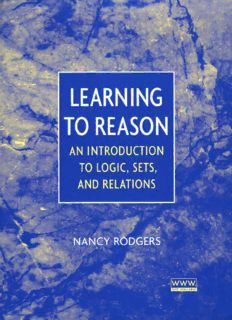
Learning to Reason: An Introduction to Logic, Sets, and Relations PDF
Preview Learning to Reason: An Introduction to Logic, Sets, and Relations
This page intentionally left blank Learning to Reason This page intentionally left blank Learning to Reason An Introduction to Logic, Sets, and Relations Nancy Rodgers Hanover College A Wiley-Interscience Publication JOHN WILEY & SONS, INC. New York • Chichester • Weinheim • Brisbane • Sineaoore • Toronto This book is printed on acid-free paper. © Copyright © 2000 by John Wiley & Sons, Inc. All rights reserved. Published simultaneously in Canada. No part of this publication may be reproduced, stored in a retrieval system or transmitted in any form or by any means, electronic, mechanical, photocopying, recording, scanning or otherwise, except as permitted under Section 107 or 108 of the 1976 United States Copyright Act, without either the prior written permission of the Publisher, or authorization through payment of the appropriate per-copy fee to the Copyright Clearance Center, 222 Rosewood Drive, Danvers, MA 01923, (978) 750-8400, fax (978) 750-4744. Requests to the Publisher for permission should be addressed to the Permissions Department, John Wiley & Sons, Inc., 605 Third Avenue, New York, NY Ю158-0012, (212) 850-6011, fax (212) 850-6008, E-Mail: [email protected]. For ordering and customer service, call 1-800-CALL WILEY. Library of Congress Cataloging in Publication Data Rodgers, Nancy, 1941- Learning to reason : an introduction to logic, sets & relations / Nancy Rodgers. p. cm. Includes bibliographical references and index. ISBN 0-471-37122-X (hardcover : alk. paper) 1. Logic, Symbolic and mathematical. 2. Proof theory. 3. Set theory. I. Title. QA9.R7264 2000 511.3—dc21 00-023492 10 9 8 7 6 5 4 3 21 This book is dedicated to the memory of Edith and Neville Rodgers Contents To Students viii To Teachers xii Logical Reasoning 1 1.1 Symbolic Language 3 1.2 Two Quantifiers 23 1.3 Five Logical Operators 36 1.4 Laws of Logic 62 1.5 Logic Circuits 77 1.6 Translations 87 Review 101 Writing Our Reasoning 109 2.1 Proofs & Arguments Ill 2.2 Proving Implications 135 2.3 Writing a Proof 141 2.4 Working with Quantifiers 149 2.5 Using Cases 160 2.6 Proof by Contradiction 168 2.7 Mathematical Induction 174 2.8 Axiomatic Systems 191 Review 209 3 Sets - The Building Blocks ... 213 3.1 Sets & Elements 216 3.2 Operations on Sets 233 3.3 Multiple Unions & Intersections .. 246 3.4 Cross Product 258 3.5 Finite Sets 271 3.6 Infinite Sets 284 Review 302 4 Relations - The Action 309 4.1 Relations 312 4.2 Equivalence Relations 325 4.3 Functions 344 4.4 Order Relations 371 Review 397 Appendix A Selected Answers 406 Appendix B Glossary 417 Appendix C Symbols 428 Appendix D Suggested Readings 430 Index 432 To Students Rarely does one hear an English major say, "I like English, but I don't like to write," yet math students often say, "I like math, but I don't like to write proofs." Some students even tremble at the sound of an approaching proof assignment. The purpose of this book is to demystify the proof process by giving you the necessary reasoning techniques and language tools for constructing well-written arguments. This skill is as essential in mathematics and computer science as in English or any other discipline. Learning to Reason is designed for a freshman/sophomore level course with no prerequisites except a desire to improve one's reasoning skills and one's ability to read and write mathe- matics and symbolic languages. The book covers the process of writing proofs, a process similar to writing in other disci- plines, but the topics for our themes (theorems) will come from three unifying concepts that run through all areas of mathemat- ics: logic, sets, and relations. We sometimes require prerequisites for math courses in order to ensure a certain level of mathematical maturity - a maturity where one becomes an independent thinker who can figure things out without being told what to do. One of the main goals of this book is to speed up this maturation process by focusing on how we reason with mathematical language, emphasizing those elements of the language that tend to confuse students in advanced courses. Simple-sounding concepts such as substitution are not as simple as they sound. Simple words, such as "and," "or," "not," and "implies," lose their simplicity when we combine them in a sentence. If you are not fluent in how to manipulate these basic terms from which we build our language, you will be severely handicapped when you try to do any type of mathematical reasoning. Another goal of this book is to help you see the common thread that runs throughout the vast universe of mathematics. Without this connection, you can easily get lost in an endless
Description: